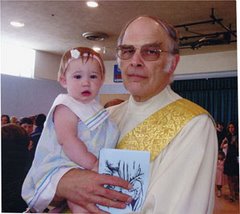John 20:1-9
Richard Dawkins is one of the most outspoken atheists in the world. He’s written books proving, at least in his eyes, that there is no such thing as God or an afterlife. He’s a very smart man and his logic has shored up many others who are atheists. Today’s gospel is about belief, and I’ll get back to Richard later.
Today’s gospel describes three encounters with the empty tomb. The first is Mary Magdalene. If all we had was John’s gospel, we would have heard about her first when she stood at the foot of the cross, and this would be the second time. She must have been well known to the early Christians. It’s said that after the Resurrection Mary went about proclaiming the “Resurrection all through the Roman empire. According to some early writers, Mary was independently wealthy and moved among the rich and famous. In some icons she is shown holding a red egg; this is because of the story that she was having supper with the emperor Tiberius. In the course of the conversation he told her that he would as soon believe the resurrection as he would believe the egg she had in her hand was red. And it became so. But we meet a younger Mary in the gospel story, who confronts the empty tomb and doesn’t believe, not yet anyway. To her the empty tomb means that the grave4 has been robbed. It will take the personal appearance of Jesus to convince her otherwise.
The second character is the beloved disciple. John never calls himself the disciple whom Jesus loved. IN fact it probably isn’t John the apostle who wrote the gospel of John. Frankly we don’t know who the beloved disciple is. Many people think John is saying something like “the beloved disciple is the ideal disciple, in contrast to the real people around him.” The beloved disciple sees what Mary saw, and believes, even though as the gospel says, he did not understand the scripture that Jesus had to arise from the dead. I assume the beloved disciple believed on the basis of the empty tomb, and that’s a hint as to the kind of faith we must have. Because in the end, you can find evidence for the Resurrection, or you can claim Resurrection is a myth. But there is no proof one way or another, and it ultimately comes down to faith, faith which is not just belief but acting on that belief.
The third character is Peter. In the light of all the gospels, Peter stands out. He’s a real person. We can all identify with him. He’s a man of great enthusiasm, and he makes powerful statements. “You are the Messiah of God” he exclaims. He steps off the boat into the sea to walk on water, but it doesn’t work and Jesus has to rescue him. He tells Jesus that if it means fellowship with him, then wash my hands and my head as well as my feet! He pledges to be with Jesus even if it means death. And then he betrays him in the courtyard of the high priest. You and I are Peter, and like Peter, we see the evidence, the empty tomb, the burial cloths , the covering of the head. And our gospel does not tell us what Peter believes. Like the beloved disciple, he also did not understand the scripture that said Jesus must rise from the dead. Later, of course, Jesus will appear to him, several times, but at this moment he’s somewhere between Mary Magdalene and the beloved disciple. Sometimes if you are like me, you are there as well.
But we have more than Peter had. We have two thousand years of history. We know what life was like before the Resurrection. Things were pretty much the same from the earliest recorded history to the time when Jesus was born. Empires rose and fell, tribes distrusted and fought other tribes, people worshipped gods by sacrificing their children to them. Kings built monuments to themselves and great tombs to assure themselves of immortality -- it didn’t matter whether it was in Egypt or China, or the Aztec empire. All over the world the bottom line was power. But after the resurrection, the world has changed. Sure, there’s always the tendency to revert back to those primitive times when might made right. It’s going on in the middle east, in Russia and the Ukraine, in Iran, in North Korea. But we have societies where there is compassion for the poor; where people are motivated to wipe out diseases, to dispel ignorance through education. We have societies in our world where people cooperate to improve the lives of citizens. We have a world where more and more people have the time and opportunity to become better versions of themselves. Do we take advantage of this? Is the work of building up God’s kingdom complete? Of course not. But there is no denying that the impact on the world of the Resurrection is real. Jesus walks among us. We encounter the resurrected Christ in scriptures, in love, in beauty, in wisdom, and in a world gradually being transformed into the kingdom Jesus promised.
Richard Dawkins, the author of “The God Delusion” has made it clear that even if he doesn’t believe in God he has called himself a "cultural Christian," appreciating the traditions, hymns, and ethos associated with Christianity,. Dawkins has also stated that if he had to choose between Christianity and other religions, he would choose Christianity, because of its societal and cultural impact. Even he recognizes the impact that Jesus Christ has made and continues to make.
You and I, Mary Magdalene and the beloved disciple, and Peter, all stand before the empty tomb and in the end, what is our response? Let it be that Jesus Christ is risen from the dead and death has been defeated, and our world is continuing to be transformed into God’s kingdom even now.



































